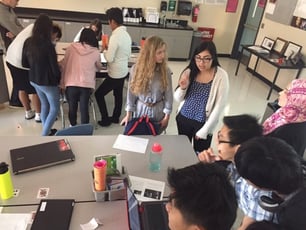Alicia Stansell is a teacher at Four Points Middle School in Austin, Texas. Alicia has a Ph.D in Learning Technologies.
Every project is a journey of discovery. Sometimes we focus so much on the destination, however, that we forget to take a moment to reflect on what has been accomplished during that journey.
Creating a simple online survey for students to complete after a project can shift the focus back to the learning journey. Often, while completing the survey, students realize for themselves what they have accomplished – or have not yet accomplished. Reflection gives students the opportunity to realize what they and their classmates have done well and how to adjust before the next project begins. The survey can also provide feedback on a variety of topics, inform future instruction, and allow the teacher to learn things they may not have known students felt. In my experience, making the survey results visible to the teacher only helps students feel comfortable being honest. Teachers may choose to share some of the survey feedback with students, but I would encourage anonymity during sharing to build trust.
Want to implement post-project surveys in your classroom? To help you get started, I've outlined a few tips below:
- Decide upon areas for reflection in the survey.
You can ask students to reflect on one area or several.
One component of the survey may focus on class presentations, for example. As students watch other student presentations or gallery-walk the projects, they can provide an overall rubric grade. While doing this, they reflect on what the expectations were, if/how they were met, and what qualifies as an exceptional project. They end up critically reflecting on the different aspects of the project, comparing solutions, and evaluating solutions other than just theirs.
A second component can be focused on peer reflections. Students may give feedback on the people with whom they worked on the project. This may look like a rubric number and/or an optional short-answer section. Not only does this reflection help students evaluate who they work well with and how to be a good group member, but it also allows you as a teacher to gain insight about what happened within the group. You can talk with the whole class, groups, or individual students to help build group skills.
A third component could be a self-reflection portion. The students report an overall rubric number and provide a written explanation for that score. This encourages the student to think about the work they did and allows you, as a teacher, to understand what their learning journey was like. Some students may have really struggled and never showed it. Another part of this section could be students explaining what they liked best and least, as well as selecting a "best in show" project. This feedback for a teacher is important to keep students engaged and improve as a facilitator in future projects. - Outline with students what your overall survey rubric will look like.
Define the adjectives or phrases that describe each of the levels of the overall rubric scale, such as 0-4. In this example, 4 could align with “Excellent Job; Above and Beyond.” Students who put a lot of time and energy into their projects enjoy knowing they will get a little extra recognition for any additional hard work they put in. In my classroom, students often define 3 as “Meets Expectations.” Historically, we have defined 2 as “Did Not Fully Meet the Expectations” with 1 defined as “An Attempt Was Made” and 0 as “No Project.”
During this process, it's helpful to talk through what good – and not-so-good – behavior and performance looks like for individuals and groups. An ideal time to do this is after the team building and first project with new students. At this point, students have a fresh view of what they think worked and did not work as a functioning group. The act of defining what makes a good group member at the start of the year helps to set the class norms and expectations. Then, at the end of each project, their peer reflection serves as a reminder of what the classroom norms are. Students have been known to use the rubric peer score adjectives to let another student know when they are not meeting the expectations by quoting the established rubric phrases and adjectives. It allows students to provide feedback that is descriptive and constructive. - Use the same post-project survey all year.
This will help simplify the process on your end. Students can simply go back to the same survey link each time, building a routine of reflection.
Having the opportunity for the students to understand their learning in a way that can be tracked over time for progress is very useful. These reflections can be given back to students during a later project and encourage individual student growth as they internalize or revisit their own reflections. Sometimes the details of success can be lost if a moment is not taken to think about that success. Using an electronic format can keep survey questions consistent and easy for teachers to implement, while also helping students know what to expect as they reflect on an ongoing basis. Teachers can get valuable feedback to help improve student groups, projects, and how they are doing as a guide. Reflections do not take long but can have a lasting impact on the classroom and feeling of success for students and teachers.
PLTW’s blog is intended to serve as a forum for ideas and perspectives from across our network. The opinions expressed are those of each guest author.

